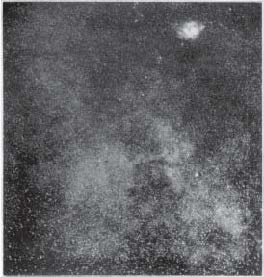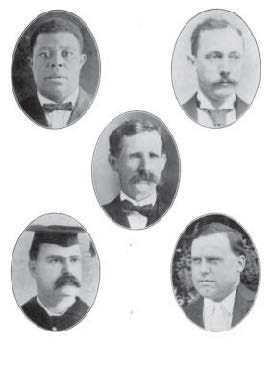
CHAPTER III
HOW THE WRITER BECAME A
MEMBER OF THE PARTY TO GO
ON THE LUNAR EXPEDITION
It was by mere accident that I became a member of the party to go on this perilous voyage. It came about thus:
I was on my way to Urbana, Ill., and was waiting in the union depot at Terre Haute, Ind., for my train. I was sitting almost alone in the south wing of the waiting room, when a well-dressed, versatile, but unassuming man apparently about forty years of age approached me and introduced himself as Ewald.
“When is the fast train bound for St. Louis, Mo., due to leave Terre Haute?” inquired he.
“I do not know,” I replied. “I am a stranger here, and not familiar with the time table.”
He then voluntarily informed me that he was directly from Westchester, Pa., had failed to make the proper railroad connections, and was due in St. Louis on urgent and important business. He then walked hurriedly away in the direction of the bureau of information.
After the lapse of about five minutes this busy man returned, took a seat and handed me a large, clean sheet of high-grade, heavy paper bearing a photo-engraving of a strange-looking craft of which he claimed to be the inventor. As I extended my arm to take it from his hand he said:
“This is an exact representation of an ethereal ship which is soon to make a safe and rapid transit from the earth to carry fifteen passengers.”
For some time this enthusiastic man talked steadily and fluently about his ship of which he was to be captain on the proposed voyage, while I gave him respectful attention. Pretty soon I arrived at the conclusion that he was of unsound mind; and for this reason I asked no further questions, and for the time being the conversation directly between him and me ceased.
Captain Ewald, as some of his newly-made acquaintances had already begun to call him, in derision perhaps, next engaged the attention of two or three well-dressed by-standers by exploiting his great invention and by his strong and spirited argument in favor of its merits.
After the lapse of some thirty minutes I again engaged him in a conversation.
“Captain, by what means do you expect to overcome the attraction of the earth and to continue your voyage,” I asked, “when your ship ascends to the limit of the earth’s atmosphere where there is absolutely nothing to offer it resistance?”

Plate 6. Star Cloud Near Messier 8.
Under most favorable atmospheric conditions less than a dozen stars on this plate can be seen from the earth’s surface with the naked eye.
[Yerkes Observatory]
“The merits of my ship,” replied he without a moment’s hesitation, “lie principally in two things, namely, its power to neutralize or to destroy the force of gravitation so that neither the attraction of the earth nor that of any other heavenly body can possibly exert any influence upon it, and the power to propel itself through the free space of the heavens at the terrific speed of three hundred and sixty miles an hour, almost six times as fast as the swiftest express train.”
I treated his assertion as a joke. That any contrivance could possess such merits as he claimed for the running gear of his ship appeared to me at that time to be utterly absurd, or as incredible as the possibility of perpetual motion; yet, the high degree of intelligence the inventor seemed to possess, his unbounded self-confidence, and his earnest demeanor, all considered together, gave me at least a little faith in him and his enterprise.
Just as the captain uttered the last word of his statement in reference to the merits of his ship, the express train destined for St. Louis arrived. By that time I was beginning to take a truly lively interest in my newly-made acquaintance and his project.
As we walked on together in the direction of the train, he introduced me to Messrs. Vanderlip and Waite, two of his young friends who were traveling with him, and told me briefly and hastily that the ship was complete in every particular, and that the departure for the moon would be taken the following week from some point near St. Louis. He stated further that the ship had been constructed strictly according to his own specifications and directly under his own observation, by skilled workmen under secrecy, and charged me particularly to make no mention of the proposed voyage in connection with his name.
He then informed me that the two young men who were with him had linked their destiny with that of his ship and would make the voyage with him, and told me that if I wished to do likewise he would, as early as possible, consider my general fitness for such a venture. I then asked the privilege to become a member of the party to go on the Lunar Expedition, and in due time it was granted. This meeting occurred on Friday, November 13, 1914.
On the following Thursday in a suburb of Alton, Ill., Capt. Ewald, according to a previous arrangement, organized the company to go on this expedition and demonstrated to the entire satisfaction of its members that his means of conveyance possessed all the merits he claimed for it.
The individual members of this company, who dared unite their destiny with that of the ship were as follows:
Captain Horace Bryson Ewald of Brockton, Mass., inventor of the mysterious running gear of the ship which carried us; Prof. Burwell Esten Rider of La Crosse, Wis., who assisted the inventor in steering the craft; Prof. Charles Ulric Thorsen of Gothenburg, Sweden, and Prof. Purdy Warford Knowlton of Birmingham, Ala., aviators while touring the moon; Prof. Daniel Crowley Monahan and Thomas Nolan Galvan, mathematicians and scientists of more than ordinary ability, late from the University of Dublin, Ireland, who made the voyage with the view to adding something to science; Dr. Marion Dade Wharton of Atlanta, Ga., our physician, who formerly held the chair of Materia Medica and Therapeutics in the Medical Department of Tulane University, New Orleans, La.; Prof. Hanson Goodwin Brunor of St. Louis, Mo., foreman in the heavy construction work of the sitting room and the dome of the ship; Prof. George Hundley Purnell of Philadelphia, Pa., machinist and electrician, who installed the air compressors, the storage batteries, and the running gear of the ship; Messrs. Walter Hummel Vanderlip and Frank Gilman Waite of Brooklyn, N. Y., photographers, and old acquaintances and friends of Capt. Ewald; the Rev. Bryan Collis Merritt of Lincoln, Nebr., a student of theology and a nephew of Dr. Wharton; Mr. Warren Newell Shipley of Brownville, Tex., Capt. Ewald’s private secretary; Dick Prouty, a typical North Carolina colored man of Bellville, Ill., who was cook during the voyage and chauffeur while touring the moon; and the writer, who went along merely to be an assistant in all light and simple matters and to see the sights.
Rev. BRYAN COLLINS MERRITT Dr. MARRION DAVE WHARTON

Prof. THOMAS NOLAN GALVAN Capt. HORACE BRYSON EDWALD
JOHN YOUNG BROWN
Mr. FRANK GILMAN WAITE

Prof. BURWELL ESTEN RIDER
Prof. HANSON GOODWIN BRUNOR
DICK PROUTY Prof. CHARLES ULRIC THORSEN

Prof. PURDY WARFORD KNOWLTON Prof. GEORGE HUNDLEY PURNELL
Prof. DANIEL CROWLEY MONAHAN